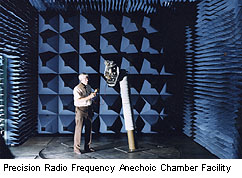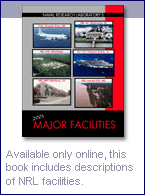Systems
GPS - The NAVSTAR Global Positioning System (GPS) Program is a DoD program to provide precise navigation data to military and civilian users by means of a constellation of 24 satellites. NAVSTAR is based on NRL’s TIMATION research program begun in 1964. NRL conceived the idea of the time-based navigational system, which led to the global positioning system.
High Frequency Radio -  NRL's development of radio equipment such as quartz crystal frequency control, high-power transmitters, and receivers led to the adoption and extensive utilization of high frequency by the Navy and had a profound effect on Naval communications for the next 50-60 years.
NRL's development of radio equipment such as quartz crystal frequency control, high-power transmitters, and receivers led to the adoption and extensive utilization of high frequency by the Navy and had a profound effect on Naval communications for the next 50-60 years.
Moon Relay - In 1951, NRL demonstrated the world’s first operational “space” radio circuit, sometimes referred to as “Project Moon Bounce.”
STU-III - NRL provided voice processing algorithms for the STU-III, which is a secure voice terminal widely deployed to support narrowband tactical and office-to-office voice communications developed by the National Security Agency.
Radar - NRL invented the first modern U.S. radar. The invention of radar and the developments that flowed from it are among the foundations of modern military power. Radar plays a major role in the operation of civilian transportation systems, weather forecasting, astronomy, and automation, among other uses.
Naval Radar Systems - Before the development of radar, Navy ships could track other ships or aircraft only by using optical techniques, sound ranging or primitive radio. NRL’s radar research led to advances such as duplexer, submarine radar, plan-position indicator, monopulse radar, airborne radar, periscope-detection radar, and over-the-horizon radar.
Monopulse Radar - Monopulse radar, which NRL developed in 1943, is the basis for all modern tracking and missile control radars.
Airborne Radar - Before America’s entry into World War, NRL developed the Model ASB radar. It was the first operational U.S. airborne radar to be widely used for bombing, detection of ships and surfaced submarines, and airborne intercept.
Over-Horizon Radar - NRL developed a low-power HF radar system called Multiple Storage, Integration, and Correlation (MUSIC). MUSIC could detect missile launches at distances up to 600 nautical miles and of atomic explosions at distances up to 1700 nautical miles.
Friend-or-Foe - In 1937, NRL developed the first Identification Friend or Foe (IFF) system in the United States. Since 1979, NRL has collaborated with the Air Force and Army to develop the new IFF systems, which are urgently needed to make efficient use of beyond-visual-range weapon systems.

